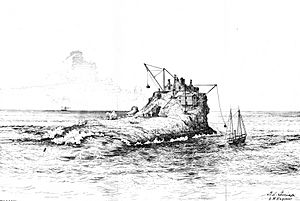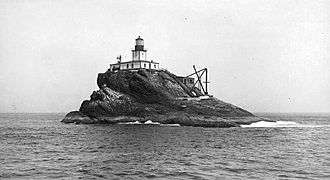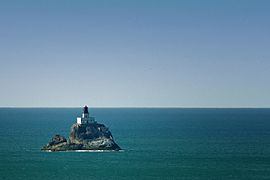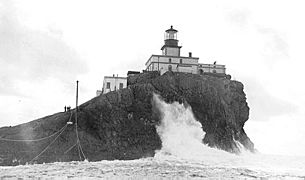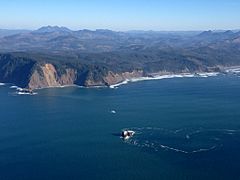Tillamook Rock Light facts for kids
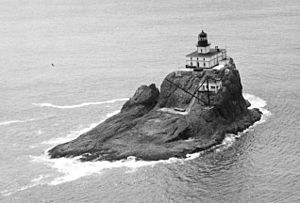 |
|
| As seen in 1947 | |
|
|
|
| Location | Off Tillamook Head, Clatsop County, Oregon |
|---|---|
| Coordinates | 45°56′15″N 124°01′08″W / 45.9375°N 124.019°W |
| Year first lit | 1881 |
| Deactivated | 1957 |
| Foundation | Concrete |
| Construction | Basalt masonry, brick, iron |
| Tower shape | Round lantern on square tower |
| Height | 62 ft (19 m) |
| Original lens | First order Fresnel lens (removed) |
| Range | 18 nautical miles (33 km; 21 mi) |
The Tillamook Rock Light is a famous old lighthouse off the Oregon Coast in the United States. People often call it Terrible Tilly or just Tilly. It sits on a small piece of basalt rock, less than an acre in size, in the Pacific Ocean. This rock is about 1.2 miles (1.9 km) from Tillamook Head.
Building this lighthouse was a huge challenge. It started in 1880 and took over 500 days to finish. In January 1881, just as it was almost done, a ship called the Lupatia crashed nearby in bad weather. All 16 sailors on board sadly died.
The lighthouse officially began shining its light on January 21, 1881. At that time, it was the most expensive lighthouse ever built on the West Coast. Because of the wild weather and dangerous trips for the lighthouse keepers and supplies, it earned its nickname "Terrible Tilly." Over the years, big storms damaged the lighthouse and even broke its main light. It stopped working in 1957 and has been owned by private groups since then. For a while, it was used as a special place for people's ashes, but that stopped in 1999. Today, it's still privately owned. The Tillamook Rock Light is listed as a historic place and is part of the Oregon Islands National Wildlife Refuge. You can see it from the towns of Seaside and Cannon Beach, and from Ecola State Park.
Contents
Building the Lighthouse
In 1878, the United States Congress set aside $50,000 to build a lighthouse. They first thought about building it on Tillamook Head. However, experts found that the Head was too tall, about 1,000 feet (300 m) high. Fog would often block the light. So, Tillamook Rock was chosen as a better spot.
Surveying the Rock
In 1879, a team led by H. S. Wheeler went to survey the rock. Wheeler first thought it would be almost impossible to land there. But he was told to keep trying. On his second try, he managed to land. Still, he found it hard to move his equipment. He reported that the rock would need a lot of blasting to create a flat area for the lighthouse foundation. This meant more money would be needed for the project.
A third survey happened in September 1879. This time, John Trewavas, an expert from England, led the team. Sadly, Trewavas was swept into the sea by large waves while trying to land. His body was never found. After this tragedy, it was very hard to find workers for the project. People were scared and wanted the project to stop.
Overcoming Challenges
Charles A. Ballantyne took over after Trewavas. He finally found a group of quarrymen who didn't know about the accident. Work on the rock started again. To get to and from the rock, workers used a special derrick (a type of crane) and a breeches buoy (a rescue device that looks like a pair of shorts on a rope). By May 1880, they had successfully blasted the top of the rock. This made a flat space for the lighthouse's foundation.
The lighthouse structure included living areas for the keepers and a 62-foot (19 m) tall tower. It originally held a large Fresnel lens and an oil lamp. The light was 133 feet (41 m) above sea level and could be seen up to 18 miles (29 km) away. It also had a loud steam foghorn. The United States Army Corps of Engineers built the lighthouse. The project cost $125,000, which was a huge amount of money back then. It was the most expensive lighthouse on the West Coast until the St. George Reef Light in California was built.
The Lupatia Shipwreck
In early January 1881, the lighthouse was almost finished. A ship called the Lupatia was sailing in thick fog and strong winds. The captain realized they were too close to shore. Wheeler, who was in charge of the lighthouse construction, heard the panicked crew. He quickly told his men to put lanterns in the tower and light a bonfire. This was to warn the ship that they were only about 600 feet (180 m) from the rock. The ship seemed to turn back towards the sea. But it quickly disappeared into the fog, and Wheeler could no longer hear the crew. The next day, the bodies of all 16 crew members were found on the shore of Tillamook Head. Only the ship's dog survived.
Lighthouse in Action
The Tillamook Rock Light first shone on January 21, 1881. Four keepers were assigned to work there. Being a keeper at Tillamook Light was very tough. It was far from towns, and the weather was often severe. This is why it was nicknamed "Terrible Tilly."
Facing the Storms
Throughout its history, the lighthouse was hit by huge, violent storms. These storms brought large waves, strong winds, and flying debris. Sometimes, the tower would flood when the lantern room windows broke. The lighthouse had four different head keepers in its first two years. In 1897, a telephone line was installed, but a storm broke it soon after. During a storm in 1912, about 100 tons of rock were reportedly torn off the western side of the rock. Over time, the windows were replaced with small portholes and covered with cement for protection.
On October 21, 1934, a massive storm hit. It destroyed the original lens and damaged parts of the tower railing and landing platform. Winds reached 109 mph (175 km/h). Boulders and debris flew into the tower, damaging the lantern room and smashing the lens. The derrick and phone lines were also destroyed. After the storm, communication was cut off. Keeper Henry Jenkins bravely built a makeshift radio from the damaged foghorn and telephone to alert officials. Diesel engines were then installed to provide electricity. Repairs cost $12,000 and were finished in February 1935. The old lens was replaced with a new aerobeacon. A metal mesh was also put around the lantern room to protect it from large rocks.
After the Light Went Out
The lighthouse stopped working in 1957. It was replaced by a whistle buoy in the water. It had become the most expensive U.S. lighthouse to operate. The last keeper was Oswald Allik.
Over the next 20 years, the lighthouse was sold many times. In 1980, a group of real estate agents bought it. They created a business called "Eternity at Sea Columbarium." This place was used to store the ashes of people who had passed away. After about 30 urns were placed there, the license for this use was taken away in 1999. They tried to get it back in 2005 but were not successful.
It is very hard to get to the lighthouse today. A helicopter is usually the only way to land on the rock. Even the owners are not allowed to visit during the seabird nesting season. The Tillamook Rock Light was added to the National Register of Historic Places in 1981. It is also part of the Oregon Islands National Wildlife Refuge.
Gallery



